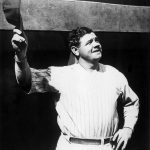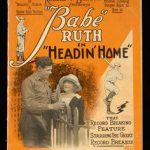Tools of Historical Fiction
Through the three historical mysteries in my “Deception” series – # 3, The Babe Ruth Deception emerged in paperback last month – I’ve turned to some unexpected tools for grounding each story in the proper time-and-place.
Because the books range from 1900 (The Lincoln Deception) to 1921 (Babe Ruth), and take place variously in small-town Ohio, Washington, Paris, and New York, each one has involved different challenges. If readers don’t believe the book’s version of the era and the location, the story doesn’t have a chance. Happily, some tools work in any situation.
- Photographs – These are invaluable guides to personal clothing (how uncomfortable were they?), hair styles, and deportment (how formal did people wish to appear?). Photos of cities reveal how they looked a century ago: the traffic, the buildings, the commercial offerings. Photos of Manhattan streetscapes in the early 1900s showed a surprising (to me) lack of women who were out and about. All were escorted by men. When it comes to landscapes and vistas, even current photos may be helpful.
Finally, photographs are essential for any real historical figures who appear in the story (say, Babe Ruth or President Woodrow Wilson in The Wilson Deception). The Babe’s disarming grin, Wilson’s triumphantly erect posture – these come through powerfully in photos. The story has to portray historical figures as they were, and as they’re known. I have distilled this inarguable point: you can make up a lot, but Abe Lincoln HAS to be tall.

Babe Ruth, 1920 — check out his posture, his expression: he knows he’s the best!
- Films and audio recordings – For my first novel, set in 1900, there were no films available, but I could see film of Woodrow Wilson and hear his voice on tape. Watching a person move can reveal much, including the impact that person may have on others; the same is true of hearing his voice, cadence, and speech patterns.

Babe on the Silver Screen!
- For Babe Ruth, I hit the jackpot. Not only are there many recordings of his voice, but the Babe made his own silent movie in 1920, Headin’ Home (you can watch all of it online here). It’s a pretty bad movie, but it offers a great look at the 25-year-old Babe, before he put on weight and suffered the dings and aches that come with age and an athletic career. The movie also gave me a key plot line for the novel, since one of New York’s most notorious gangsters financed the film, then was indicted for bribing eight members of the Chicago White Sox to throw the 1919 World Series . . . but I shouldn’t give away the story!
- Places – Being at the actual location of the story can give an immediacy – the sounds and light around a place, or the impact of a building’s design on the eye. For The Babe Ruth Deception, I visited the Wall Street shrine of J.P. Morgan Co., where a terrorist bombing took place in 1920, and also the Ansonia Hotel on Broadway in Manhattan (below, now deluxe condos), where the Babe lived in arriviste splendor.

- Novels! – For the writer of historical fiction, one puzzle is everyday speech: what words people used, what kinds of slang was current, and how they put words together. To get a feel for such things, I like to read novels written during the period. To learn about 1920 speech patterns, I turned to Main Street by Sinclair Lewis and This Side of Paradise by F. Scott Fitzgerald. Having the story in 1920 gave me a small advantage. My mother, born in 1917, had a virtually inexhaustible supply of sayings, slang and piquant phrases. If I was tempted to put into a colloquial phrase into a character’s mouth, I tried to imagine my mother saying it. If I could hear her it in her voice, I used it.
A final point. Though I rely on historical research (and always include an Author’s Note to explain what events in the story are real) it’s important not to overdo it. It’s fiction, after all. Novelists use their imaginations, and so do readers. Edgar Rice Burroughs made a fortune with his Tarzan books, yet never set foot in Africa, while Frank Herbert wrote six novels about the universe of Dune without ever visiting that planet.
Prolific novelist Lawrence Block captured this idea in his book Writing the Novel:
All our stories are nothing but a pack of lies. Research is one of the tools we use to veil this deception . . .but this is not to say that the purpose of research is to make our stories real. It’s to make them look real, and there’s a big difference.
Dear Sir,
I recently had the pleasure of reading “Impeached’ and I wanted to express my admiration and gratitude to you. For me it was a wonderfully readable and well balanced account of a devilishly complex (and very significant) historical event.
In reading the notes section I came to better understand just how much work you put into this project–well done!
Thank you for your dedication
Rob